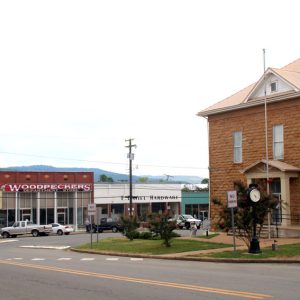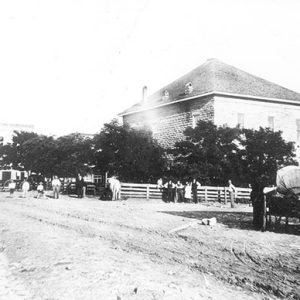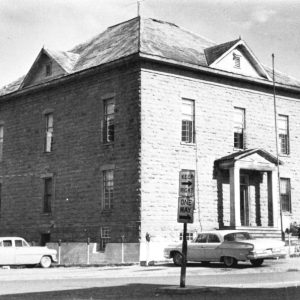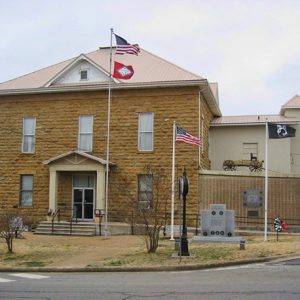calsfoundation@cals.org
Searcy County Courthouse
The Searcy County Courthouse is in the historic commercial district of Marshall (Searcy County). Built in 1889, this two-story building, made of stone native to the area, stands as one of the oldest courthouses in Arkansas. The Arkansas Historic Preservation Program recognizes the courthouse as architecturally and historically significant as an outstanding example of an Arkansas Adamesque building. It was listed on the National Register of Historic Places on October 12, 1976.
Since Searcy County turned eleven acres into its county seat in 1856, three courthouses have managed local affairs. The first was a log cabin, one of the few structures in town at that time along with a two-story hotel, a mercantile store, and a collection of houses. At the beginning of the Civil War, the state Confederate government exposed a pro-Union group called the Peace Society, captured ninety members, and kept them in the courthouse. Southern forces conscripted eighty-seven of them into Colonel John S. Marmaduke’s Eighteenth Arkansas Infantry.
In 1864, the Second Arkansas Cavalry (US), made up of soldiers from Arkansas and Missouri, rode into Burrowville (sometimes spelled Burrowsville), as present-day Marshall was then known, after a skirmish with Confederate guerrillas. Subsequently, the courthouse burned down along with its county records, presumably an act carried out by the Union cavalrymen. Searcy County built a wooden courthouse in 1868; however, an accidental fire leveled it in 1886.
At an October session in 1887, the Searcy County Quorum Court appropriated only $2,200 toward the new courthouse’s construction. The county’s commissioner of public buildings drew plans for the building, and the Quorum Court approved them at a meeting the following January. After the bidding process ended, the county agreed to a contract with McCabe & Greenshaw of Missouri on April 2, 1888, as it had offered the lowest bid, $29,000. Later, the bid grew to $33,100 as recommended by the county commissioner for additional plans. The Quorum Court offered appropriations worth $11,400 for the project and no more, still leaving funding far below the agreed upon bid.
Searcy County accused McCabe & Greenshaw of finishing a courthouse only $11,000 in value and refused to pay out the remaining $24,000. William H. Thompson, who was affiliated with the contracting firm, sued Searcy County for the remaining money the county owed. Judge Amos M. Thayer of the District Court of Eastern Arkansas heard the case and ruled for plaintiff Thompson, stating that the contractor’s work “was done in accordance with the plans and specifications,” and discovered that there had been no funds in the county treasury since 1886. His ruling stated that the plaintiff “was entitled to recover 33 1/3 per cent of the [remaining appropriations’] face value,” meaning the county owed the firm $8,000.
Both plaintiff and defendant took the case to the Eighth Circuit Court of Appeals, which upheld the lower court’s ruling on September 18, 1893. The opinion stated that Searcy County “made a bad bargain,” and had “no right to enter into a contract for a building of a courthouse at a cost exceeding the sum that had been appropriated by the Quorum Court for the [courthouse’s] erection.”
The orange native-stone building is small in comparison to its fellow seats of justice. It sits on a 90′ x 90′ plot, with only enough space outside for patches of grass, stone benches, and three historical markers telling the county’s history. Behind the paneled front doors, wooden wainscoting reaches part way up to the twelve-foot-high ceilings. The floors are made of oak, and pine woodwork can be found throughout the interior.
In the 1950s, Searcy County constructed a two-story annex that houses the county record vaults. Since 1989, the Arkansas Historic Preservation Program and its County Courthouse Restoration Grant Program have awarded grants to Searcy County, for uses such as repairing the gable roof and stonework, renovating the basement, and making the courthouse compliant with the Americans with Disabilities Act (ADA).
For additional information:
Baker, William D. History and Architectural Heritage of Searcy County. N.p.: n.d.
Gill, John Purifoy, and Marjem Jackson Gill. On the Courthouse Square in Arkansas. N.p.: 1980.
“Searcy County Courthouse.” National Register of Historic Places nomination form. On file at Arkansas Historic Preservation Program, Little Rock, Arkansas. Online at http://www.arkansaspreservation.com/National-Register-Listings/PDF/SE0010.nr.pdf (accessed August 26, 2020).
“Thompson v. Searcy County.” The Federal Reporter: Cases Argued and Determined in the Circuit Court of Appeals and Circuit and District Courts of the United States 57 (October–December 1893): 1030–1037.
Jared Craig
Arkansas Historic Preservation Program
 Historic Preservation
Historic Preservation Post-Reconstruction through the Gilded Age, 1875 through 1900
Post-Reconstruction through the Gilded Age, 1875 through 1900 Marshall Courthouse Square
Marshall Courthouse Square  Marshall Street Scene
Marshall Street Scene  Searcy County Courthouse
Searcy County Courthouse  Searcy County Courthouse
Searcy County Courthouse 




Comments
No comments on this entry yet.